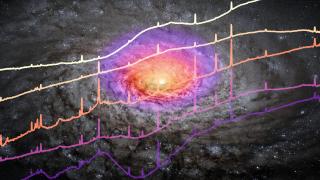Bibcode
Ricci, Federica; Treister, Ezequiel; Bauer, Franz E.; Mejía-Restrepo, Julian E.; Koss, Michael J.; den Brok, Jakob S.; Baloković, Mislav; Bär, Rudolf; Bessiere, Patricia; Caglar, Turgay; Harrison, Fiona; Ichikawa, Kohei; Kakkad, Darshan; Lamperti, Isabella; Mushotzky, Richard; Oh, Kyuseok; Powell, Meredith C.; Privon, George C.; Ricci, Claudio; Riffel, Rogerio; Rojas, Alejandra F.; Sani, Eleonora; Smith, Krista L.; Stern, Daniel; Trakhtenbrot, Benny; Urry, C. Megan; Veilleux, Sylvain
Bibliographical reference
The Astrophysical Journal Supplement Series
Advertised on:
7
2022
Citations
33
Refereed citations
30
Description
Virial black hole (BH) mass (M BH) determination directly involves knowing the broad-line region (BLR) clouds' velocity distribution, their distance from the central supermassive BH (R BLR), and the virial factor (f). Understanding whether biases arise in M BH estimation with increasing obscuration is possible only by studying a large (N > 100) statistical sample of obscuration-unbiased (hard) X-ray-selected active galactic nuclei (AGNs) in the rest-frame near-infrared (0.8-2.5 μm) since it penetrates deeper into the BLR than the optical. We present a detailed analysis of 65 local Burst Alert Telescope (BAT) selected Seyfert galaxies observed with Magellan/FIRE. Adding these to the near-infrared BAT AGN spectroscopic survey database, we study a total of 314 unique near-infrared spectra. While the FWHMs of Hα and near-infrared broad lines (He I, Paβ, Paα) remain unbiased to either BLR extinction or X-ray obscuration, the Hα broad-line luminosity is suppressed when N H ≳ 1021 cm-2, systematically underestimating M BH by 0.23-0.46 dex. Near-infrared line luminosities should be preferred to Hα until N H < 1022 cm-2, while at higher obscuration a less-biased R BLR proxy should be adopted. We estimate f for Seyfert 1 and 2 using two obscuration-unbiased M BH measurements, i.e., the stellar velocity dispersion and a BH mass prescription based on near-infrared and X-ray, and find that the virial factors do not depend on the redshift or obscuration, but some broad lines show a mild anticorrelation with M BH. Our results show the critical impact obscuration can have on BLR characterization and the importance of the near-infrared and X-rays for a less-biased view of the BLR. *This paper includes data gathered with the 6.5 m Magellan Telescopes located at Las Campanas Observatory, Chile.
Related projects

Nuclear Activity in Galaxies: a 3D Perspective from the Nucleus to the Outskirts
This project consists of two main research lines. First, the study of quasar-driven outflows in luminous and nearby obscured active galactic nuclei (AGN) and the impact that they have on their massive host galaxies (AGN feedback). To do so, we have been granted time with the Gran Telescopio CANARIAS (GTC) in the optical and near-infrared ranges
Cristina
Ramos Almeida